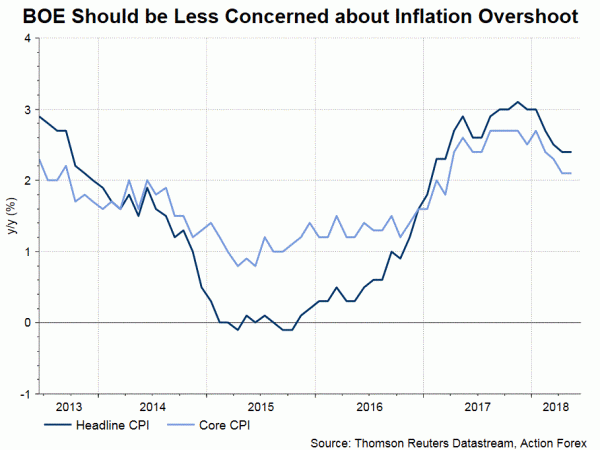Last month, BOE left the policy rate at 0.5% and the asset purchase program at 435B pound. It acknowledged the growth slowdown in the first quarter but noted that more information is needed to confirm whether it was driven by temporary factors. Although deputy governor Dave Ramsden suggested earlier this month that the intermeeting data has “confirmed” that the first quarter slowdown was driven by temporary factor, i.e., adverse weather condition, we believe moderation in inflation and lukewarm wage growth would likely keep the central bank on the sideline. Six weeks’ date since the last meeting would not be sufficient for the central bank to change its stance. Equally, the incoming data since then is not justified for the central bank to confirm the “temporary factor” rhetoric.
Inflation has been softening after BOE’s rate hike last November. In May, both headline and core CPI stayed unchanged at 2.4% y/y and +2.1%, respectively. These are compared with recent peaks of +3.1% and +2.7% in November last week. Meanwhile, RPI eased -0.1 percentage point to +3.3% y/y in May from a month ago. The key contributor to the moderation was housing price, of which the ONS index dropped to a weak 3.9% y/y. Overall, the inflation report suggests that the worry about inflation overshooting is behind us and BOE is far less obliged to raise the policy rate to ease the price level when compared with 2H17. On the job market, claimant count dropped -7.7K in May, better than expectation of 11.3K rise. Unemployment rate stayed unchanged at 4.2% in the 3 months through April, the lowest rate since 1975. However, wage growth remained lukewarm. Average weekly earnings, including bonus, slowed to +2.5% y/y during the period, worse than both consensus and March’s reading of +2.6%.
– advertisement –
Concerning different sector activities, the Markit report shows that manufacturing PMI recovered in May, climbing higher to 54.4 from April’s 17-month low of 53.9. While staying in the expansionary territory, both April and May readings are still lower that the average 54.9 in 1Q18. The services PMI improved to 52.8 in April and then to 54 in May, from 51.7 in March. The average reading for April and May, at 53.4, is only mildly higher than first quarter’s average of 53.07. We find it difficult to confirm from these indicators that the disappointment in 1Q18 is over.
Deputy governor Dave Ramsden is convinced that “the data we have had so far suggests our interpretation of the slowdown in Q1 as temporary looks to be being borne out”. He noted that “consumer confidence and consumer credit both picked up in the latest data, as did retail sales and several business surveys. That included the latest services [Purchasing Managers’ Index] output balance, representing 80% of the economy. So far at least our May judgement looks on track”. This view is not shared by the statistics department. With the second estimate of the GDP staying unrevised at +0.1%, ONS’s head of GDP Rob Kent-Smith suggested that, “the economy performed poorly in the first quarter” overall. While admitting that “poor weather” hit “construction and high street shopping”, he noted that “this was offset to an extent by increased energy supply and online sales”. The ONS believes that there was evidence of an underlying growth slowdown in the first quarter.
The June meeting does not include updated economic projection or a press conference. As such the meeting minutes would be in focus, serving as an indicator for the likelihood of an August rate hike. If hopes of an August rate hike falter, the chance of a November hike would be more remote. Hawkish Ian McCafferty is leaving the Committee and would be replaced by Jonathan Haskel, an Imperial College Business School professor.


 Signal2forex.com - Best Forex robots and signals
Signal2forex.com - Best Forex robots and signals




